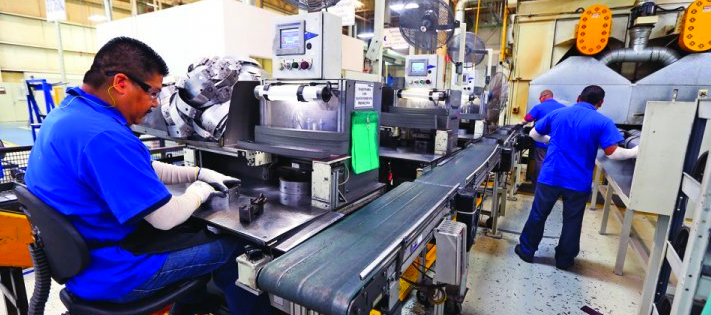
Remittances to Latin America & the Caribbean in 2014
In 2014, remittances to Latin America and the Caribbean grew 4%, reaching at least $62.3 billion.
A Daily Publication of The Dialogue
Low productivity has been the primary culprit for Latin America’s limited capacity to transform productive resources into high-quality goods and services, according to a report released last month by CAF-Development Bank of Latin America. What are the reasons behind Latin America’s persistently low productivity rates, and what consequences do they have on the region’s overall growth? What measures should policymakers and businesses implement to reverse this trend? To what extent do noneconomic factors such as weak rule of law and bureaucracy play a role in the region’s stagnant productivity measures, and what can be done to improve countries’ business environments in relation to these areas?
Alicia Bárcena, executive secretary of the U.N. Economic Commission for Latin America and the Caribbean: “Labor productivity in Latin America relative to the United States has been falling since the 1980s and has also trended lower since the end of the 1950s relative to the current members of the European Union, when it was equivalent to 76 percent, falling to just 41 percent in 2015. This decline continued even in the 1990s, when the region embarked on a program of trade opening and privatization that was expected to boost productivity. Falling labor productivity in Latin America in the aftermath of the global economic and financial crisis of 2008-2009 can be partially explained by a decline in gross fixed capital formation, which contracted significantly over the period. This has directly affected the rate of productivity growth, since modern technological innovations are embedded in the most recent additions to the capital stock. The impact of this trend is compounded by the fact that the region’s productive structure remains concentrated in activities whose competitiveness depends on natural resources and/or low wages, rather than on innovation and new technologies and capabilities. The leading sectors of the region’s economy have weak linkages with the rest of the production structure, giving rise to a heterogenous structure in which the difference in productivity levels in small- and medium-size firms (which provide most employment) and large firms is much higher than in developed economies. Weak productivity can also be explained in how Latin America invests in human capital. Despite gains in access to primary and secondary education in the region, serious concerns about quality remain. Investment in education is key for boosting labor productivity growth. The region also invests little in innovation: R&D expenditures are below 1 percent of GDP, with a notable exception being Brazil. This weighs heavily on productivity levels, limiting the incorporation of new technology in the productive structure. Limited investment in R&D also has the concomitant effect of reducing demand for a highly trained labor force that can make use of these innovations. Finally, the region’s pervasive inequality has deleterious impacts on production system efficiency, leading to loss of opportunities, incentives and resources for learning and innovation.”
Jaana Remes, member of the Advisor board and partner at the McKinsey Global Institute: “While reform initiatives and the short-lived rise in commodity prices lifted millions out of poverty, Latin America continues to experience sluggish growth and unequal distribution of the gains of that growth. Our new McKinsey Global Institute report highlights a ‘missing middle’ of firms and consumers that will need to be filled if Latin American economies are to regain their erstwhile dynamism and restore inclusive growth in the region. Among firms, it finds a missing cohort of vibrant midsize companies that could bring dynamism and investment to expand the number of productive and well-paying jobs in Latin America, much as these firms do in many high-performing emerging regions. Large and midsize companies with more than $50 million in revenue are less prevalent for the size of the Latin American economy as compared with peers elsewhere. The second missing middle is a cohort of upwardly mobile consumers with rising disposable income. Despite poverty reduction efforts, more than 150 million people in the region have not reached a comfortable middle-class existence. They remain unable to afford goods and services that go beyond basic needs and may not have access to credit. Productive, well-paid jobs have been too scarce to meet the needs of the expanding labor force. These missing consumers are a drag on the economy, as they limit demand and growth of markets for domestic firms. Filling in these missing middles may not solve all of Latin America’s economic challenges, but it will go a long way to boost productivity and broad-based prosperity.”
Welby Leaman, senior director of global government affairs for the Americas at Walmart: “One lesson from the CAF report is that informality, corruption and weak rule of law in Latin America sap the productivity of businesses and workers that operate within the informal sector. Yet that harm does not stop at the border between the informal and formal sectors. High-compliance-standard businesses and workers, too, could generate more productivity gains for Latin American economies were it not for the disincentive of informality, corruption and weak rule of law. Walmart’s ‘Despensa Familiar’ grocery format in the Northern Triangle is well-designed to expand formality and raise ‘total factor productivity’ in underserved Class C and D communities by combining the right mix of local agricultural sourcing, formal careers, capital and customer surplus. But in retail and other sectors, local sourcing networks fray and investment lags if weak rule of law and misunderstandings about how to strengthen it cause avoidable distrust between buyers and suppliers and between the public and private sectors. Gear-slipping is common in rule-of-law efforts that rely on just one or two of Douglass North’s three institution-building components: legal norms, informal cultural norms and enforcement. We can be more productive at strengthening rule of law if we better combine these three ‘factors’ and increase hours worked on this challenge by recognizing a leadership role for the private sector. In short, we can raise productivity in Latin America in part by more productively working across sectors to strengthen rule of law.”
Matteo Grazzi, senior specialist in the Competitiveness, Technology and Innovation Division at the Inter-American Development Bank: “The low productivity of LAC economies has been acknowledged as the main reason of the disappointing long-run economic performance of the region. This is the result of multiple factors, but a key element is the scarce effort of the region in terms of innovation and dynamic entrepreneurship. In fact, most LAC countries underinvest in science, technology and innovation (STI). For example, LAC average R&D intensity as percentage of GDP (a generally accepted indicator of innovation effort) is only around 0.7 percent, compared to more than 4 percent in benchmarking countries such as South Korea and Israel. This is due not only to insufficient public investment, but also, and especially, to the scant participation of the private sector in this effort. On average, in LAC firms’ R&D intensity (expressed as a percentage of sales) is below 0.4 percent, considerably lower than 1.61 percent in Europe and 1.89 percent in OECD countries. This situation is the result of macroeconomic and regulatory factors, but also of the specific strategies and decisions of individual LAC firms. A recent IDB book presents the results of recent original microeconomic evidence relating to LAC countries, confirming that innovation is a key engine of productivity growth, but that its impact depends on the specific characteristics of the firm and on the availability of additional complementary assets, such as access and use of digital technologies, access to finance and external markets, and on-the-job training. This implies that a sound institutional and regulatory framework is a necessary condition for allowing productivity gains, but that, once these barriers are reduced, firms will respond to the same framework in different ways, depending on their characteristics. Then, once the basic framework is put in place, the achievement of further efficiency improvements within firms will require detailed microeconomic policies that address the internal factors that hinder firm-level innovation, technological upgrading, improvements in management and organization, development of technical human capital and entry into export markets.”
The Latin America Advisor features Q&A with leaders in politics, economics, and finance every business day. The publication is available to members of the Dialogue's Corporate Program and others by subscription.
In 2014, remittances to Latin America and the Caribbean grew 4%, reaching at least $62.3 billion.
With the recent decline in commodity prices, why have some countries have fared better than others?
With Brazil’s state oil company Petrobras engulfed in a massive corruption scandal, the government looks poised to introduce an energy sector overhaul.
 Factory workers in Ciudad Juárez, Mexico, are pictured above. // File Photo: Mexican Government.
Factory workers in Ciudad Juárez, Mexico, are pictured above. // File Photo: Mexican Government.

